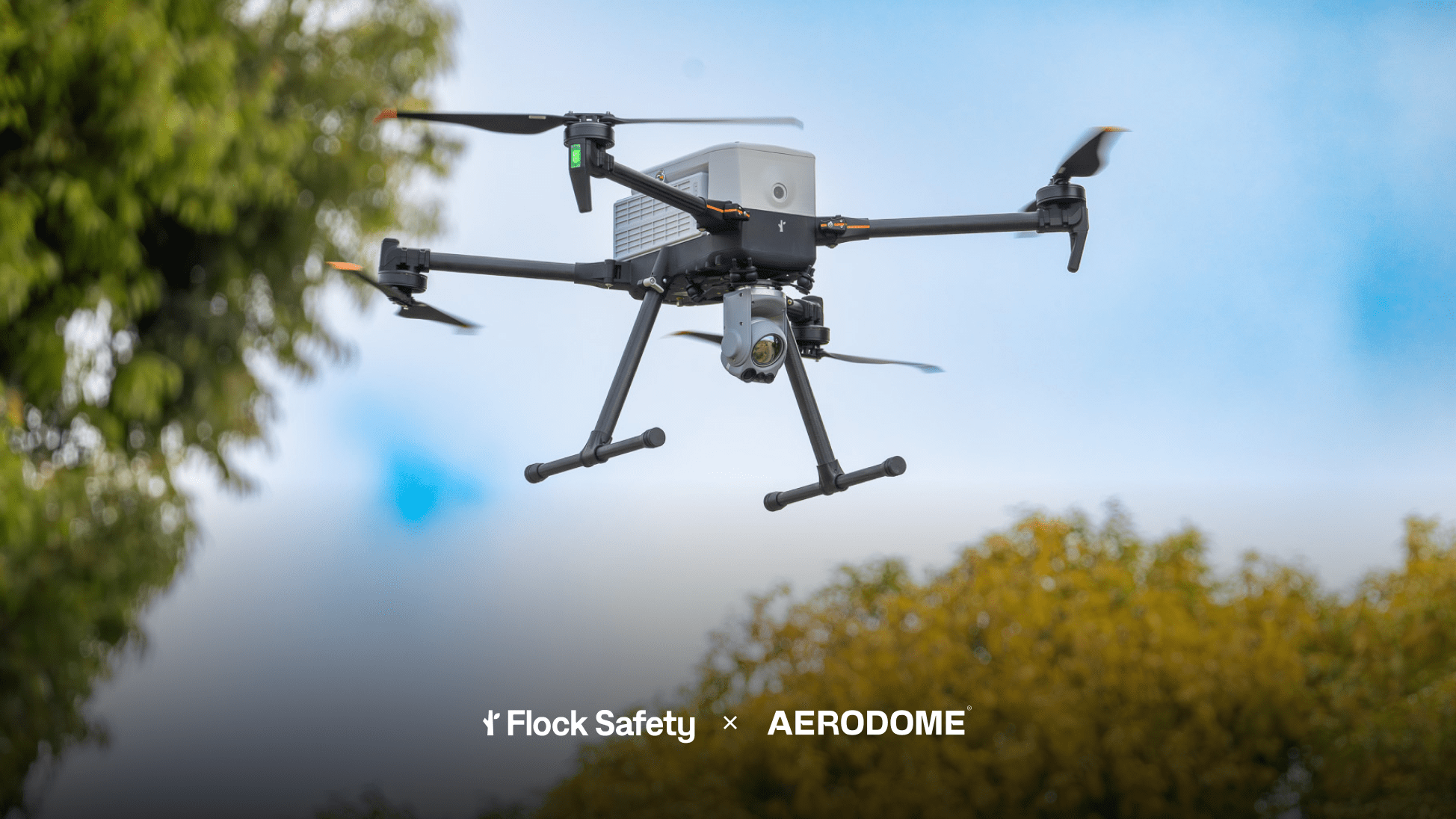
The 5 A's of DFR: The DNA of a Drone-As-First-Responder Program
(This Blog Post is taken from an original article by the same author that first appeared in Police1.com)
Defining DFR
DFR is simply defined as a First Responder deploying immediately to a scene via drone, allowing them to arrive quickly and safely, with the best view of what’s happening at the scene.
It's worth re-reading that sentence above. It’s critical to truly understanding DFR. The system an agency chooses to conduct DFR must enable the First Responder to provide value. After all, the drone’s purpose is just delivering a payload, and in the case of DFR, the payload is the First Responder. A drone on scene without a First Responder involved adds little value. How can a drone assist if no one is controlling it, knowing what to look at, reporting what they see to others, gathering intel, coordinating action, etc?
The term “DFR” has been used to describe general public safety drone use. To be clear, DFR is a very specific type of drone deployment, with the key feature being the drone arriving before ground units. DFR, in its true form, is a system set up to launch a drone within seconds of learning of an emergency.
To determine if an agency’s operation qualifies as a DFR program, use this simple benchmark: measure the time from when the drone pilot first becomes aware of an incident to the moment a drone is launched and en route. If this process takes more than a minute or two, it’s not DFR. (Side note: If an agency isn’t able to be en route via drone before the call hits the computer aided dispatch system (CAD), it's not quite done building its DFR Program—see video for more).
Operational Objectives
To be effective, a DFR system must be capable of doing three things:
Get there,
Get there fast,
See Sh!t.
1) Get there
Ultimately, to be useful, a DFR system has to be able to fly far enough to reach the emergency. The camera, or battery life, or flight speed are irrelevant if it doesn’t have the range to get there. The further it can fly the more incidents it can reach. Many systems don’t have a robust enough radio or command and control (C2) system to stay connected for long distances in congested radio frequency (RF) environments. Therefore, when evaluating DFR systems, it’s important to select one that has adequate C2 range, ideally about 3 miles. Shorter ranges mean more launch locations (more drone systems) needed to cover the same area.
2) Get there fast
Second, the drone must be able to get to its intended location quickly. Even if it has a strong C2 and can ultimately reach the location (“get there”), it’s not very useful if it takes so long the emergency is over or ground units are already there.
Getting there fast has three components:
How fast does the pilot learn of the emergency (what and where it’s happening)
How fast the drone launches
How fast the drone flies
The total response time is the sum of these. Here is a deeper look at each:
Learning of the emergency: Most agencies that have robust DFR programs also have tools like Flock, Live911, Shotspotter, or other pre-CAD notification systems that give them the earliest indication of what and where emergencies are happening. The best systems have integrations with these solutions as well as integrations with the CAD system, allowing the pilot to populate the destination location and launch the drone with a single click of the mouse Look at these solutions when standing up your DFR program.
Launch speeds: If the DFR system of choice utilizes a docking station, understand how long this launch process takes. Sometimes the launch speed can take several minutes. The dock may be slow to open, and/or the drone may take time to connect to enough satellites before taking off. A drone that takes more than a minute to deploy will eat into the overall emergency response time. Also, docking stations with contact charging may take 40 minutes to an hour to recharge the batteries. For faster re-deployment, look at systems that utilize battery swapping technology.
Flight Speed: Pick a drone that flies fast. Some of the remote operations software systems out there artificially limit the stock flight speed of the drone. Pay attention to how fast the drone flies when using third-party piloting applications.
3) See sh!t
Finally, the pilot must be able to clearly see what’s important once on scene. For some reason, this is the most underappreciated aspect of DFR by the industry. But ask any experienced DFR pilot what is the most critical component in their equipment and typically they will have the same answer–“The camera!”
If the pilot can’t see details on the ground, the response via drone will provide very little value for most emergency incidents. For some common emergencies like traffic accidents and fires, almost any drone camera capability will suffice to confirm that something is happening and where it is. But most police calls aren’t that cut and dry or static. Many are rapidly moving. A First Responder arriving via drone will need to search large areas for missing persons or fleeing suspects, but also read license plates, identify real vs. fake guns, see faces, get addresses, see what’s in people's hands, etc. For this, they will need a powerful camera, especially if they are flying at optimal height.
The higher the drone flies, the more area on the ground the pilot can see. Low altitude narrows the field of view. Think of it like looking through a telescope. Finding a target is hard through a telescope, so one must first use the naked eye to find the point of interest, then use the telescope to see details. This is the same for DFR. A First Responder via DFR must first locate the fleeing vehicle, suspicious person, etc. This is hard to do from low altitude with a limited field of view. A pilot can exponentially increase their field of view by flying at higher altitudes, then utilize the zoom to instantly “be on the ground” and see the details needed for effective incident resolution.
Also, regarding zoom capability, stand-off angles can be at a significant distance when having to see in doorways and under overhangs and canopies. A powerful zoom is crucial to see details from hundreds if not thousands of feet away. (This is over and above the night vision capabilities).
In short, if the agency’s drone of choice for DFR doesn’t have an awesome camera, they won’t be happy with it.
Background
The origin story of DFR is becoming well known. The first official DFR Program became operational in October of 2018 and over these last 6 years, the concept has gained broad acceptance and programs are taking flight across the U.S., Mexico, Canada, UK, Europe, and Australia. It is estimated that scores of public safety agencies have some form of DFR operation ongoing today, with more than 100 exploring implementation into their community.
Selecting and deploying the technology, operational protocols, training, approvals and waivers needed to have an effective DFR operation are the challenges public safety agencies face in standing up their program. These challenges can be categorized into 5 different areas that we will define and explain.
The 5 A’s of DFR
The first section of this paper discussed the 3 essential capabilities that DFR systems must have; the ability to get there, get there fast, and see sh!t. There are building blocks to enable these capabilities, and these are considered the DNA of a DFR system. From the agency’s perspective, these can be considered “problems” that must be solved in building its DFR program. Each problem starts with an A, and comprises the 5 A’s of DFR.
1) Aircraft
This of course refers to what type of drone and its associated capabilities the agency decides to use. Is it going to be a quadcopter with the ability to hover and provide a stable view of a fixed point, but with limited flight time? Or is it going to be a fixed wing that can stay aloft for longer, fly faster, but perhaps provide a less stable view of a fixed point in high winds? What type of camera is needed? Does it have thermal capabilities? Is the camera’s zoom powerful enough to read a license plate or recognize a person at an altitude of 300-400 feet AGL with a 45% downward facing angle?
DFR is about speed; does the drone fly fast enough? Does it launch quickly? How long does it take to recharge, or are the batteries hot-swappable? These are just some of the considerations, and an agency’s choices will be limited if the drone selection isn’t integrated with or conducive to some of the other A’s listed below.
Aerodome is hardware agnostic and integrates with best-in-class partners. Aerodome is also developing integrations with NDAA-compliant options as well as different aircraft solutions for different types of missions. Aerodome will always provide customers with access to the best drones legally available for DFR.
2) Aircraft Management
This refers to the process of launching, landing, and recharging the aircraft. Early stage DFR programs (DFR 1.0) like Chula Vista Police Department’s require a human to change batteries and ensure safe take-off and landing. Companies like Flying Lion are helping agencies effectively fill this need. The holy grail is an automated dock system that does the work of a human, so DFR is less expensive and operational over longer periods and different weather conditions (DFR 2.0).
Does the aircraft/drone the agency selected (1:A) use humans to manage the aircraft, or does the system utilize a docking station? Does the docking system have contact recharge that takes considerable time, or does it hot-swap the batteries and allow immediate take off? Does it protect against the elements, and provide on-board cameras for site safety and aircraft inspection? What is the launch time of the dock? Does the time to launch eat into the overall response time significantly? Does the command and control link (C2) impact the ability of the drone to get there? Does the launch speed, time to connect to satellites, and flight speed impact the ability to get there fast? Does the dock system integration limit the flight speed of the drone?
For early stage programs (DFR 1.0), Aerodome partners with Flying Lion. For those seeking DFR 2.0, Aerodome has an exclusive integration and partnership with Hextronics, providing the only battery-swapping drone dock system on the market. The system is specifically designed and built for DFR with rapid deploy/launch times. The dock can be adapted to work with a variety of drones. Aerodome software unlocks the maximum speed of the drones in use, allowing drone speeds at over 50MPH.
3) Autonomy and Remote Operations
The most fundamental software features require the ability to remotely control the drone, with automated features like return-to-home and position-hold capabilities. Often, other software features utilize geo-fencing or other obstacle avoidance capabilities. Does the remote operations (RO) software selection integrate airspace alerts like radar, ADS-B, Remote ID, and/or radio frequency (RF) drone detection? What is the drone’s behavior with loss link, or airspace incursions with other aircraft? What autonomy features in the RO software enable the pilot to multi-task, see augmented reality (AR) overlays that show streets, addresses, and points of interest (POI) locations? Where is the pilot getting the information about what is happening and where, i.e. what are the drone launch trigger sources? Is the RO software integrated with the agency’s CAD system? Is it integrated with pre-CAD data sources like Flock or Live911? Does the software integrate with the dock system to allow multi-drone operation and in-air drone swapping for sustained overwatch?
Aerodome’s software is the best-in-class remote operations system on the market. It’s specifically designed for DFR by a team experienced at building solutions for public safety. Aerodome’s CEO, Rahul Sidhu, has hundreds of actual DFR missions under his belt and understands the workflow of Aerodome’s customers. The system is designed to be easy-to-use and safe, with systems that make community engagement, evidence retention and sharing, and emergency response simple for any pilot. Integrations with 3rd party solutions allow first responders to learn of an emergency quickly, launch to pre-populated destination locations, and take advantage of AR overlays that make knowing where you are and where you are going easy to see and relay to ground units.
4) Airspace Awareness
This refers to the process of ensuring the drone doesn’t hit anything. There are two reasons to satisfy this requirement. The first reason, of course, is to avoid actually hitting anything. And the second reason is to meet the regulatory requirement by the FAA to have an ability to detect and avoid (DAA) other aircraft or flying objects. This DAA requirement is critical to enable beyond visual line of sight (BVLOS) flight. Currently, virtually all DFR operations are done using humans on the roof who maintain a clear view of the airspace and alert the remote pilot of possible hazards (DFR 1.0). This person doubles as the solution to Aircraft Management (see above).
Does the DFR system utilize a radar system or other visual aid that can replace a human eye? What is the range of this solution? Does it work day and night?
Aerodome has an exclusive partnership with O.W.L. Radar systems, which is the lowest cost, most effective 3-D radar system on the market. The capability promises to enable effective Detect and Avoid (DAA) capability. The radar is one of four systems that Aerodome integrates into its Air Traffic Awareness Module: Radar, ADS-B in, RF Detection, and Remote ID. This layered approach is much better and more effective than human Visual Observers (VO). The key is the alerting system that allows pilots to be aware without the need to monitor several different data sources. Any aircraft that nears the police drone sets off an alarm and allows them to mitigate. As the aircraft nears the drone, the alarm becomes more intense, allowing for automated elevation reduction should the pilot be unaware or disabled.
5) Approvals
This refers to the formal FAA authority (BVLOS waiver) to operate based upon the solution described above in Airspace Awareness. Has the agency met the DAA requirement to satisfy the FAA and receive the waiver to operate without any humans on the roof? The FAA isn’t the only stakeholder with a say. Does the agency have permission from city leadership and the community it serves to fly drones to emergency calls? Does the agency plan on flying routine random missions, or does it limit flights only to actual incidents or 911 calls to ensure community trust? Does the RO software have transparency tools to share flight data with the public, record statistical data, and enable accountability against abuse?
Aerodome DFR 2.0 is getting the “humans off the roof.” To do that, you need a dock system that effectively manages the aircraft and a DAA system that maintains airspace awareness. This combination is what agencies have been waiting for. Aerodome crafts the BVLOS COA/waiver request in partnership with the customer to give the FAA what they need to allow DFR 2.0, enabling a single remote pilot to deploy drones rapidly to emergencies without the need to staff rooftops. Aerodome also has a robust Community Engagement module that provides important information to the agency and outside stakeholders to ensure accountability and maintain transparency.
Conclusion
All the 5 elements (5 A’s) above comprise the DNA of DFR and combine to provide a system designed to get there, get there fast, and see things. DFR provides considerable promise for increased safety, reduced response times, and improved de-escalation capabilities for public safety agencies. The successes of those who have paved the way have proven the value and addressed the concerns of the communities they serve. It’s clear that agencies considering DFR today are facing a daunting task if going it alone. They must invest time and resources, solving for each of the 5 A’s, to do it effectively and responsibly. DFR will truly scale and spread to almost any community when the industry provides turnkey solutions while supporting customers who are already resource challenged. Those who seek DFR should evaluate how private industry solution-providers address each of the 5 A’s.
Please take the time to demo Aerodome as you evaluate the various DFR options available. Aerodome’s business plan is specifically designed to address each of the 5 A’s so the customer doesn’t have to.
Get in
Contact us to learn about pricing, deployment
options, and the future of air support.

